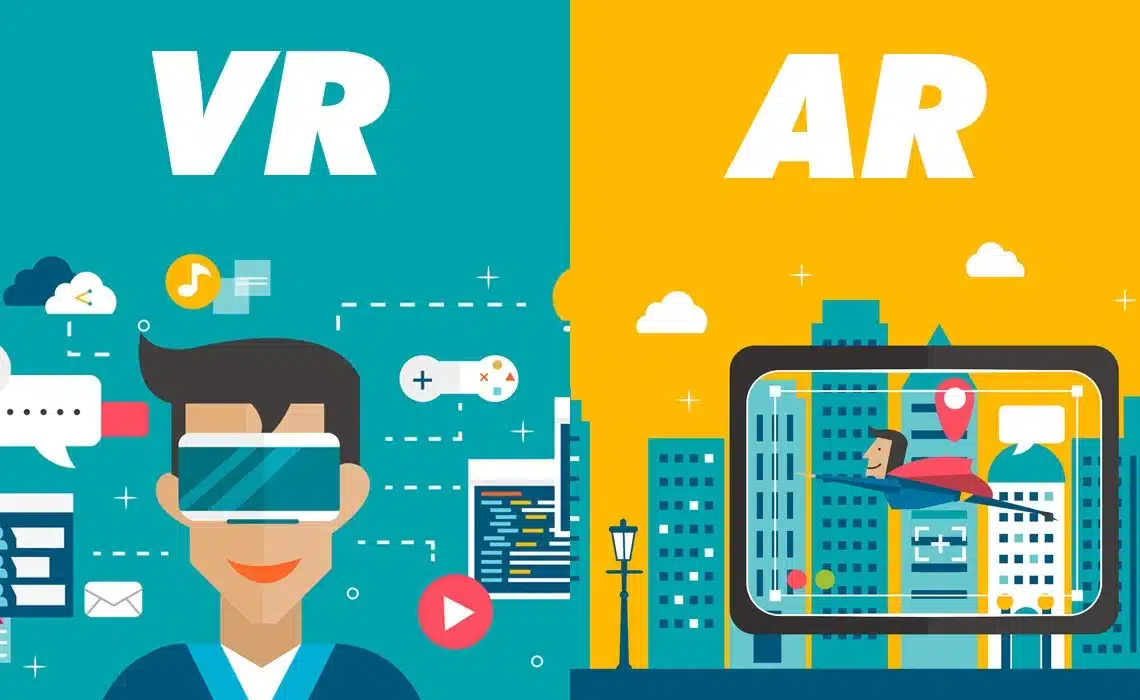Augmented Reality
that enriches the user’s perception and provides a live view of the real world with digital information. The goal is to make the real world seem bigger by adding images, sounds, videos, and other virtual details. AR is meant to add to the real world by letting virtual elements interact with real objects to create the meanings that were intended.
In AR, virtual environments that are designed to be informative coexist with the real world by giving more information about the real world. So, how does this technology work?
Most of the time, you don’t need special equipment to make an augmented reality. Instead, most ARs are made with common devices, mostly smartphone cameras. AR systems put virtual three-dimensional (3D) objects and environments on top of real-world objects in real time based on their geometric relationships. This is possible because the systems figure out where and how each object is in relation to the others.
Today, mobile phone technologies like GPS, 3G, 4G, and remote sensing are often used with AR technology. Most of the time, the combined image is shown on mobile screens, AR glasses, and other devices.
AR systems include Snapchat filters, virtual dressing rooms, interior design apps like IKEA mobile, virtual battlefields, and games like Nintendo’s Pokémon Go. AR is also used a lot in marketing and healthcare and medical applications.
Virtual Reality
Virtual reality (VR) is a technology and method that turns 3D digital images and videos into real-looking visual experiences for users. So, how do you use virtual reality?
The goal of virtual reality is to make it seem like you are in a life-size 3D digital environment. Most VR systems use computer vision and advanced graphics to add depth and figure out the size and distance between static two-dimensional (2D) images to make 3D images and videos that look like the real or made-up world. All of this is meant to replace a real environment with a simulated one, giving you the feeling that you are part of the computer-generated digital environment you are looking at.
Users use computers and sensory tools like VR headsets and gloves to explore and control 3D worlds. Because the VR headset and controllers have special lenses and sensors, users can see and interact with virtual content as if they were in the real world.
Some new VR gadgets are even better than 3D. They have real-time tracking features that make it possible to use VR for real-time explorations and let users experience their VR environment with all five of their senses.
Entertainment apps like video games, education apps like classroom training, and business apps that are usually used for virtual meetings are all examples of VR.
Virtual reality vs. augmented reality
AR and VR are both meant to give users a computer-generated 3D experience, but each technology is different and can be used in different ways. So, what’s the main difference between AR and VR?
One big difference between the two is that VR tends to replace the real world up to the point of total immersion, while AR tries to add the virtual by projecting digital information on top of what the user is already seeing.
Also, because VR tends toward full immersion, devices need to block users’ views of the real world in order to show them VR content. So, the best way to try VR is with special gear like a VR headset or gloves. At the same time, AR can be used very easily in both 2D and 3D environments, such as on a smartphone.
What are the pros and cons of augmented reality?
As with any technology, AR has its pros and cons, which are often compared to those of VR. AR can give users a whole new, interactive experience.
AR is a great way to learn because it can give you a lot of information and context about what you are seeing. AR could help users learn more and become more aware by giving them a better experience. It allows for personalised learning, which helps the process of learning. AR technology lets people share their experiences in real time with people who are far away.
One of its other benefits is that its applications are easy to use because AR systems are less likely to be limited by the device. Since there is no need for a head-mounted display, AR gives smartphone users more freedom and gives AR developers and marketers more ways to make money.
Users just have to point their camera at an object, and the AR app will show what it does with that object. Even so, you still need a high bandwidth to make high-resolution, lifelike objects for the best experiences.
AR’s biggest benefit is that it is now used in many different fields, such as games, marketing, education, and health care, and has many uses for training, learning, navigation, design, and entertainment (Snapchat, Google Lens, IKEA Place, et cetera). But the lack of privacy and safety is a big problem with AR. It could have a big effect on the whole idea of augmented reality.
Aside from its other problems, it is still not widely used in everyday life. AR technology isn’t spreading as quickly as it could because 3D systems that make and support 3D visualisations, especially in real time, aren’t as good as they could be. AR-based projects and applications are still hard to make, implement, and keep up-to-date, and they cost a lot.
And it’s important to remember that too much AR use can be bad for your health. AR activities that are done too often or too intensely can cause major health problems, like eye problems, obesity, mental health problems, and so on.
What are the pros and cons of virtual reality?
VR does have some good points, and the use of this technology has already made a difference in a number of areas.
First of all, VR helps make a world that looks and feels real so that users can explore and experiment in an artificial environment that they can interact with. VR is more immersive and gives you a sense of being there than AR does. It makes people who play games or watch videos feel like they are in a different world.
One of the best things about VR is that it makes learning and practising easier, safer, and more comfortable for the person using it. One of the best things about technology is that it makes it possible to train and practise potentially dangerous real-world tasks like surgery, flying an aeroplane, or fighting without putting anyone in danger.
On the other hand, training in a virtual reality environment will never be the same as practising and working in the real world. This is one of the biggest problems with the technology. So, even if a user does well with simulated tasks in a 3D VR environment that was made for them, that doesn’t mean they would do well with the same tasks in the real world.
Also, the high cost of VR systems makes them less likely to be used every day. VR devices are not cheap, so not everyone can buy one. Even though the price of VR technology has gone down over the years, it is still not widely used. Low adoption means that there aren’t many VR systems on the market, which makes customers’ choices more limited.
There are also many worries about health. VR could be bad for people’s health. The technology needs to be improved before people can use it without getting headaches, blurry vision, or feeling sick.
Another thing to think about is the possibility of progressive escapism. It became a long-term norm for VR users, who then started to live in virtual environments instead of dealing with the real world. After spending a lot of time in the virtual world, they grew to like it more. As a result, they used VR even more, which made it harder for them to interact with people in the real world.
Uses of Augmented reality
AR apps basically let people do cool things that are specific to their location or that connect virtual and real-world objects and experiences.
There are different kinds of AR apps. AR apps are used a lot in retail and advertising, for example. AR could make the customer experience better by showing 3D models of products and helping people make better choices. AR apps can help customers find their way to virtual stores and rooms.
They can improve remote design, give users a virtual walkthrough of a given piece of real estate or a better idea of how a sofa will fit in their house, or let them look at furniture from home and choose pieces that will fit their space.
AR technology is used by the printing and advertising industries to put 3D digital content on top of real newspapers and magazines. This helps companies get their brands known to users.
In addition to putting ads on AR content, tourists can use AR apps to find their way around by getting information about destinations, directions, and things to see. Users may be able to get suggestions for hotels to stay at or look at a menu before deciding what to order. AR also makes it possible to travel without leaving home.
AR apps can also help drivers get to their destinations, show speed statistics, help with advanced navigation, and mark objects in real time.
There are also a lot of augmented reality games like Pokémon GO, Jurassic World Alive, etc., and many of them are based on blockchain, like DogemonGo and Terra Virtua. The technology makes it easier to make real-time 3D games that are better to play. AR is making it possible for users to play games in virtual environments that are more like the real world.
Collaboration from afar is another use case. Using AR apps, professionals in manufacturing and maintenance can tell repair technicians how to do repairs and maintenance work even when the repair technicians are not on site.
AR can be used to train healthcare workers, diagnose patients, plan for and keep an eye on health emergencies. Fitness AR apps can show regular users their heart rates and other health data on the screen while they work out.
AR is also being used more and more in architecture and urban design to help people see how building projects will look. It is also used for transportation projects and to rebuild and plan cities.
Uses of Virtual reality
Applications for virtual reality give you a full sensory experience that simulates an artificial environment digitally. These kinds of apps can be made in many different areas.
VR applications are most often and most often used for entertainment. Immersive video game experiences, virtual music concerts, travel simulations, and the ability to watch movies and scenes in 360 degrees are just a few examples.
VR can show high-definition, interactive 3D images, which makes it a great opportunity and a different way to market and advertise digitally.
VR technology makes it possible for employees to meet and work together without being in the same room. Businesses can use it to come up with new ideas, test them before launching them, or talk about them with partners and collaborators. VR makes it easy for engineers and designers to try out different looks and designs for a car before ordering expensive prototypes.
VR is also a proven way to help people get better. Immersive virtual reality technology can create real-time 3D environments that look and feel like the real world. It is used in the social sciences, psychology, and clinical therapy because VR visuals can help patients forget about their pain and change how pain signals get to the brain.
In the past few years, VR has become one of the most common ways to treat PTSD. Now, VR apps are often used to calm patients, help them deal with anxiety, and treat social disorders and autism. VR systems are used as digital training tools for medical simulations because people are becoming more distant from each other.
VR is used to train and learn in many different fields besides healthcare simulation. For example, the military uses VR to simulate things like flight and battle. It is also used in sports to set up the right conditions for playing and to help athletes measure how well they do and figure out how to improve. This kind of training helps people learn skills without having to use them in the real world. It saves money and doesn’t put people in danger.
VR could also change and make education more accessible by letting people learn interactively and through experience from anywhere in the world.
What does (MR) stand for?
Mixed reality (MR) is a combination of augmented reality (AR) and virtual reality (VR). It is the merging of the virtual and real worlds to create a new world where virtual and real things can interact in real time.
Unlike VR systems, which completely immerse users in virtual worlds, or AR systems, which add digital content on top of the real world without taking into account its unique and changing structure, MR systems constantly gather new information about the environment and what is happening in it. MR brings the virtual and real worlds together so that they are connected.
MR is a field that is growing quickly. MR has been used in entertainment, education, design, healthcare, military training, marketing, and working from home, among other places.
Also, AR, VR, and MR are all connected to extended reality in a way that can’t be broken (XR). XR brings together the digital and the real world and combines human-machine interactions by letting people wear devices and headsets.
What part virtual and augmented reality play in the metaverse
The metaverse is a simulated digital environment that combines different kinds of technology, like AR, VR, MR, blockchain, and social media, to make spaces that are like the real world and make it easier for people to interact with each other.
As a shared 3D virtual space with online infrastructure and real-time events, the metaverse is expected to change the way people interact with each other by connecting the virtual and real worlds.
AR and VR technologies are key to the creation of the metaverse because they bring the real and the virtual together. Augmented reality technology lets you put 3D images into the real world and lets you interact with them in real time.
VR is seen as an important part of the new metaverse ecosystem because it gives users an immersive experience in a moving 3D virtual world. In general, the metaverse is something that users could jump into (through VR) or bring into their reality (via AR).
The idea of the “metaverse” has been one of the hottest tech trends lately, especially after Facebook said it was changing its name to “Meta” and big companies like Microsoft, Google, and Sony started using their own platforms or investing in the metaverse.
There are many metaverses out there now, like the popular virtual world Decentraland (MANA), the Pokemon-inspired play-to-earn metaverse game Axie Infinity (AXS), and the digital gaming platform The Sandbox (SAND).
***





